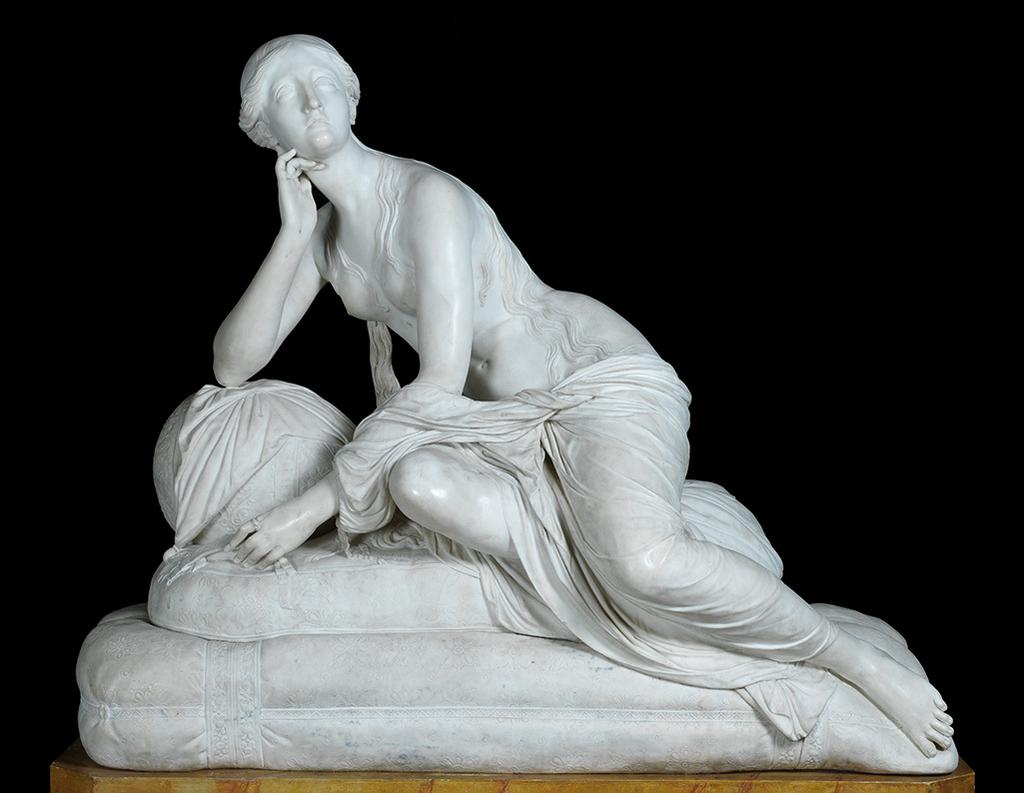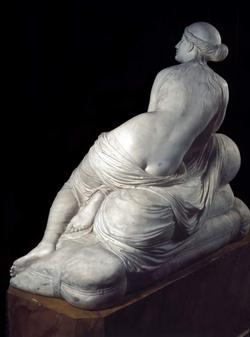Current Location: Founder's Entrance Hall Upper Landing
Titles
La Pia Contrita or Maddalena
Translated as: The Penitent Magdalene
Maker(s)
Sculptor:
Marchesi, Pompeo
Entities
Categories
Description
Figure of a partly draped nude woman with long hair dressed in Grecian style, seated on two rounded rectangular cushions, with her left leg extended behind her and her right bent up underneath her, She leans forward and rests her right elbow on a cushion in front of her, holding her right hand up to the right side of her jaw and neck. Her left arm, partly covered by her drapery, is extended in front of the cushion, and she gazes upwards.
Notes
History note: Made for Duca Pompeo Litta Visconti Arese and by 1840 situated in a grotto in the Nymphaeum of the Villa Lainate, near Milan; reputedly from a palazzo in Rome; purchased in England by Gallery Heim, London, and exhibited in their Autumn Exhibition, 1972, Paintings and Sculpture 1770-1830
Legal notes
Purchased with the Cunliffe, Perceval and Webb Funds, aided by the Friends of the Fitzwilliam, the Pilgrim Trust and Grant-in-aid from the Victoria and Albert Museum
Measurements and weight
Height: 106.5 cm
Width: 160 cm
Acquisition and important dates
Method of acquisition: Bought
(1974-07-25)
by
Gallery Heim
Dating
19th Century
Production date:
AD 1832
Note
Like 'Venus Pudica' (M.6-1974), this sculpture of ‘The Pious Penitent’ or ‘Magdalene’ was commissioned by Duke Pompeo Litta Visconti Arese for his residence in Lainate (Milan). A finished model was shown in the Brera, Milan, in 1831, described as ‘la bella convertita’ (‘the beautiful convert’) with the explanation that Marchesi was attempting to portray the moment of conversion.
In 1831, the Genoese poet Felice Romani composed a grandiose poem featuring Marchesi’s statues of Venus and Magdalene as two contrasting muses, one joyful (love), the other serious (religion), in conversation.
Marchesi was the leading Neoclassical sculptor in Milan during the first half of the nineteenth century, whose output was influenced by the work of Canova, under whom he had studied between 1804 and 1809. He established a large and prolific studio, and was Professor of Sculpture at Milan’s fine art academy between 1838 and 1852. Many of his models, including the full-scale plaster model for this work, are preserved in the Galleria d’Arte Moderna in Milan.
School or Style
Neoclassical
People, subjects and objects depicted
Project
Materials used in production
White marble
Techniques used in production
Carving
: Marble
Inscription or legends present
- Text: P. MARCHESI, F/MILANO 1832
- Method of creation: Inscribed
- Type: Signature
References and bibliographic entries
Identification numbers
Accession number: M.7-1974
Primary reference Number: 31227
External ID: CAM_CCF_M_7_1974
Stable URI
Audit data
Created: Saturday 6 August 2011
Updated: Monday 18 December 2023
Last processed: Tuesday 29 July 2025
Associated departments & institutions
Owner or interested party:
The Fitzwilliam Museum
Associated department:
Applied Arts





